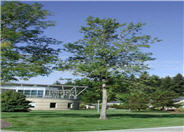
Common name:Oregon Ash
Botanical name:Fraxinus latifolia
Oregon Ash is a Pacific Northwest and California native deciduous tree that grows 50-80 ft high. It grows well in areas where it is subjected to standing water during the winter. It attracts butterflies.
-Cornflower Farms
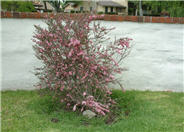
Common name:Helene Strybing Manuka Tea Tree
Botanical name:Leptospermum scoparium 'Helene Strybing'
New Zealand Tea Tree has small, needle-like green leaves with showy, 1/2" rose-like flowers in winter and spring. These shrubs can be thinned to enhance their attractive branch structure and flaking bark. They need very little water once established. 'Helene Strybing' grows 6-10' tall by 5-8' wide. It has an open structure with deep pink blooms.
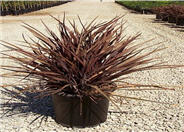
Common name:Amazing Red Flax
Botanical name:Phormium 'Amazing Red'
Phormium 'Amazing Red' is an evergreen perennial. Big, dramatic plant composed of many swordlike, stiffly vertical leaves in a fan pattern. Flowers stems reach high above leaves, bearing clusters of 1-2 in. blossoms in red.
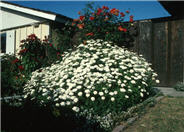
Common name:White Lady Marguerite
Botanical name:Chrysanthemum frutescens 'White Lady'
This annual perennial has bright green foliage and produces an abundance of round, pure white flowers.
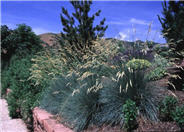
Common name:Blue Oat Grass
Botanical name:Helictotrichon sempervirens
The blue oat grass is a evergreen blue clumping grass that grows 12-18 in. tall and wide. Its showy flowers are 1-2 ft. above the foliage. This plant looks good alone as well as in mass plantings. The blue oat grass likes dry hill sides and is drought tolerant. -Cornflower Farms
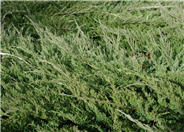
Common name:Buffalo Juniper
Botanical name:Juniperus sabina 'Buffalo'
Buffalo Juniper is a wide-spreading, low-growing, very hardy sub-shrub with bright green foliage. It presents a softer look than most junipers, and is an excellent ground cover. Like most junipers, it grows best in full sun and well-drained soil.
| Designer: | Rocks Stabilize Slope |
Photographer: GardenSoft |
Soils and Compost:
Incorporate compost 6" into your soil to retain water, reduce compaction, feed earthworms, and provide valuable nutrients to your plants.
Water Saving Tip:
Use water saving equipment, e.g. rain or soil-moisture sensors, MP rotator nozzles, weather-based controllers, and low-volume irrigation (drip systems, soaker hoses, and microsprayers).
Integrated Pest Management:
Develop healthy soil for plants that are vigorous and naturally pest-resistant.
